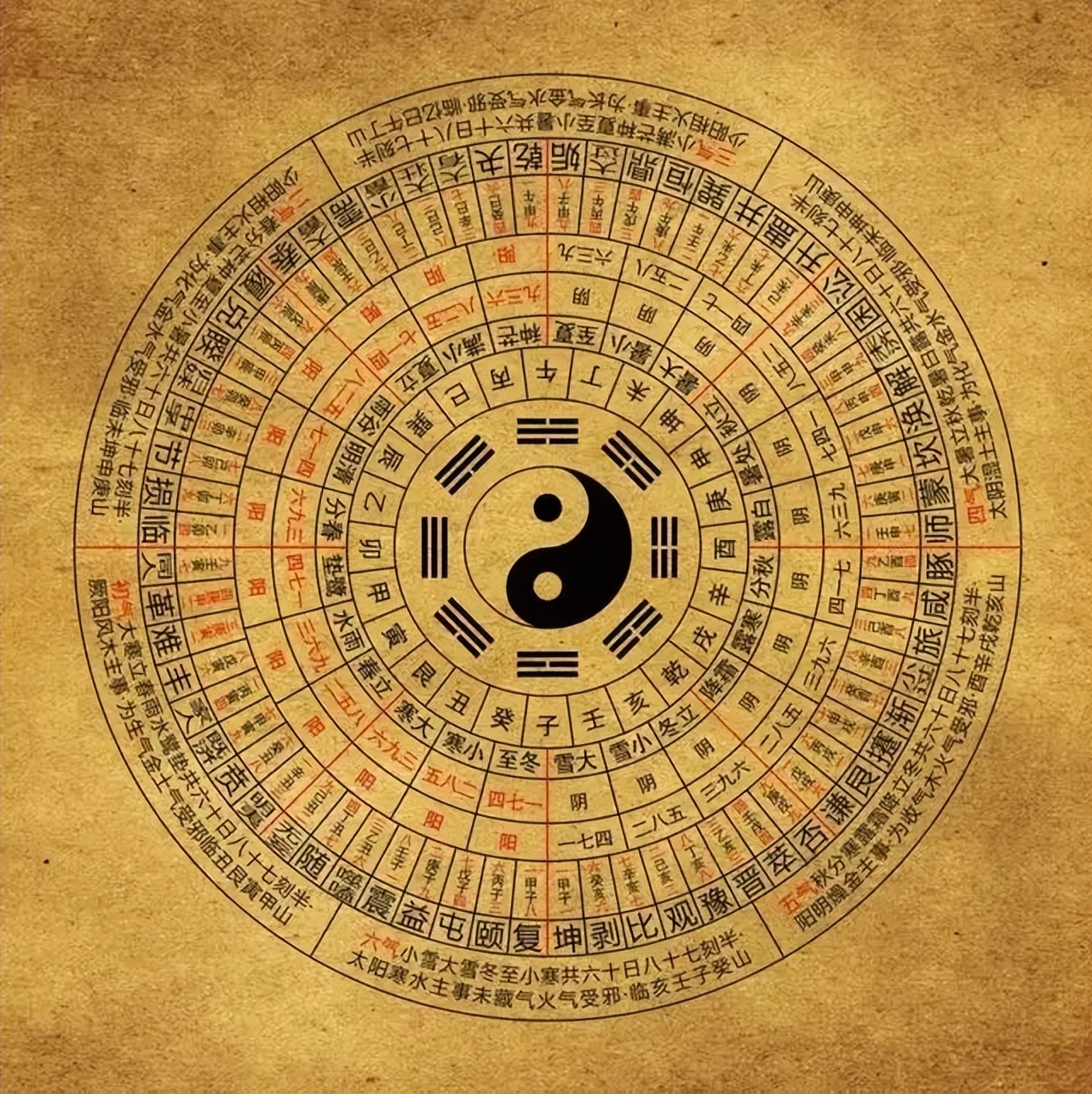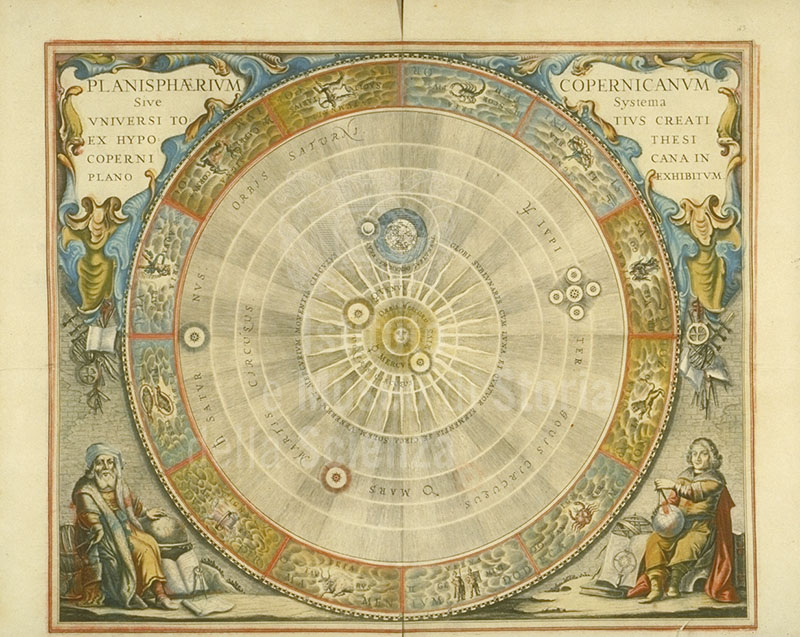
漢德百科全書 | 汉德百科全书
 天文
天文


Das Yerkes-Observatorium ist eine historische, 1897 eingeweihte Forschungsstätte für Astronomie in den USA. Sie liegt in der Nähe Chicagos am Lake Geneva im Bundesstaat Wisconsin, ist aber heute wegen der zunehmenden Luft- und Lichtverschmutzung kaum mehr in Verwendung.
Finanziert wurde das Observatorium von Charles Tyson Yerkes, einem US-amerikanischen Industriellen, nach dem es auch benannt wurde. Die Hauptkuppel beherbergt das bis heute größte Linsenteleskop der Welt mit einem 102-cm-Objektiv und 19,7 Meter Brennweite.
耶基斯天文台(/ˈjɜːrkiːz/ YUR-Keez),英语:Yerkes Observatory,或译为叶凯士天文台)是位于美国威斯康星州威廉姆斯湾的天文台。这个天文台从1897年建立至2020年都由芝加哥大学的天文学和天体物理学系运营[2][3]。

Das I Ging, hist. Romanisierung, heute: Yijing (chinesisch 易經 / 易经, Pinyin Yìjīng, W.-G. I-Ching ‚Buch der Wandlungen od. Klassiker der Wandlungen‘) ist eine Sammlung von Strichzeichen und zugeordneten Sprüchen. Es ist der älteste der klassischen chinesischen Texte. Seine legendäre Entstehungsgeschichte wird traditionell bis in das 3. Jahrtausend v. Chr. zurückgeführt. Das Werk ist im Chinesischen allgemein auch als Zhouyi (周易, Zhōuyì ‚Wandlungen der Zhou‘) bekannt.
《易经》是中国汉族最古老的文献之一[1],并被儒家尊为“五经”之始;一般说上古三大奇书包括《黄帝内经》、《易经》、《山海经》,但它们成书都较晚。《易经》以一套符号系统来描述状态的简易、变易、不易,表现了中国古典文化的哲学和宇宙观。它的中心思想,是以阴阳的交替变化描述世间万物。《易经》最初用于占卜和预报天气,但它的影响遍及中国的哲学、宗教、医学、天文、算术、文学、音乐、艺术、军事和武术等各方面,是一部无所不包的巨著。自从17世纪开始,《易经》也被介绍到西方。在四库全书中为经部,十三经中未经秦始皇焚书之害,它是最早哲学书。自从十七世纪开始,《易经》也被介绍到西方。
《易》原有三种版本:《连山》、《归藏》和《周易》[2],《连山》和《归藏》已经失传,一般所称《易经》即源于《周易》发展而来。
《易经》包括狭义的《周易》与《易传》。《周易》相传是依循周文王主编《易》的著述而来,成书大约在西周时期。由于随时代演变,《周易》文字含义到了春秋战国时代已经不便读懂,因此孔子撰写了“十翼”,后世又称为《易传》并列入《易经》。
『易経』(えききょう、正字体:易經、拼音: )は、古代中国の書物。『卜』が動物である亀の甲羅や牛や鹿の肩甲骨に入ったヒビの形から占うものであるのに対して、『筮』は植物である『蓍[1]』の茎の本数を用いた占いである。商の時代から蓄積された卜辞を集大成したものとして易経は成立した。易経は儒家である荀子の学派によって儒家の経典として取り込まれた。現代では、哲学書としての易経と占術のテキストとしての易経が、一部重なりながらも別のものとなっている。中心思想は、陰陽二つの元素の対立と統合により、森羅万象の変化法則を説く。著者は伏羲とされている[2]。
中国では『黄帝内經』・『山海經』と合わせて「上古三大奇書」とも呼ぶ。
The I Ching (/ˈiː ˈdʒɪŋ/),[2] also known as Classic of Changes or Book of Changes, is an ancient Chinese divination text and the oldest of the Chinese classics. Possessing a history of more than two and a half millennia of commentary and interpretation, the I Ching is an influential text read throughout the world, providing inspiration to the worlds of religion, psychoanalysis, literature, and art. Originally a divination manual in the Western Zhou period (1000–750 BC), over the course of the Warring States period and early imperial period (500–200 BC) it was transformed into a cosmological text with a series of philosophical commentaries known as the "Ten Wings".[3] After becoming part of the Five Classics in the 2nd century BC, the I Ching was the subject of scholarly commentary and the basis for divination practice for centuries across the Far East, and eventually took on an influential role in Western understanding of Eastern thought.
The I Ching uses a type of divination called cleromancy, which produces apparently random numbers. Six numbers between 6 and 9 are turned into a hexagram, which can then be looked up in the I Ching book, arranged in an order known as the King Wen sequence. The interpretation of the readings found in the I Ching is a matter of centuries of debate, and many commentators have used the book symbolically, often to provide guidance for moral decision making as informed by Taoism and Confucianism. The hexagrams themselves have often acquired cosmological significance and paralleled with many other traditional names for the processes of change such as yin and yang and Wu Xing.
Le Yi Jing (sinogrammes 易经simpl./易經trad., pinyin yì jīng, Wade-Giles i4 ching1, également orthographié Yi King ou Yi-King), prononcé en français i ting est un manuel chinois dont le titre peut se traduire par « Classique des changements » ou « Traité canonique des mutations ». Il s'agit d'un système de signes binaires qui peut être utilisé pour faire des divinations. Le Yi Jing s'appelle aussi Zhou Yi (周易, pinyin : Zhōu Yì, Wade-Giles : Chou1 I4) c'est-à-dire « changements de Zhou » pour la raison que son élaboration date du Ier millénaire avant l'ère chrétienne, époque des Zhou (1027, 256 av. J.-C.).
Il occupe une place fondamentale dans l'histoire de la pensée chinoise et peut être considéré comme un traité unique en son genre dont la finalité est de décrire les états du monde et leurs évolutions. Premier des cinq classiques, il est donc considéré comme le plus ancien texte chinois.
Le Yi Jing est le fruit d'une recherche spéculative et cosmogonique élaborée, dont les articulations ont influencé durablement la pensée chinoise. Sa structure mathématique a impressionné Leibniz qui y aurait vu la première formulation de l'arithmétique binaire. De fait, partant d'une opposition/complémentarité entre les principes d'engendrement Yin et Yang (yin // réceptif // lune // femelle // passif alors que yang // créatif // soleil // mâle // actif) et subdivisant cette dualité de façon systématique (adret = côté au Soleil alors qu'ubac = côté à l'ombre ; vents favorables opposés aux nuages contraires), le Yi Jing arrive à la série des 64 figures qui peuvent interpréter toutes les transformations possibles.
« Le Yi-King ou Livre des transformations de l'archaïque magie chinoise apporte l'image la plus exemplaire de l'identité du Génésique et du Génétique. La boucle circulaire est un cercle cosmogonique symboliquement tourbillonnaire par le S intérieur qui à la fois sépare et unit le Yin et le Yang. La figure se forme non à partir du centre mais de la périphérie et naît de la rencontre de mouvements de directions opposés. Le Yin et le Yang sont intimement épousés l'un dans l'autre, mais distincts, ils sont à la fois complémentaires, concurrents, antagonistes. La figure primordiale du Yi-King est donc une figure d'ordre, d'harmonie, mais portant en elle l'idée tourbillonnaire et le principe d'antagonisme. C'est une figure de complexité. »
— Edgar Morin, La Méthode 1. La Nature de la Nature, p. 228, Seuil, Paris, 1977.
Il Libro dei Mutamenti[2] (易經T, 易经S, YìjīngP, I ChingW[3]), conosciuto anche come Zhou Yi 周易 o I Mutamenti (della dinastia) Zhou, è ritenuto il primo dei testi classici cinesi sin da prima della nascita dell'impero cinese. È sopravvissuto alla distruzione delle biblioteche operata dal Primo imperatore, Qin Shi Huang Di.
L'Yi Jing è diviso in due porzioni, jing 經 o 'classico' e zhuan 傳 o 'commentario', composti in momenti differenti ma tramandati come testo unico da due millenni circa. La porzione jing è composta da sessantaquattro unità, ognuna basata su un esagramma (gua 卦) composto di sei linee che sono o continue (⚊) rappresentanti il principio yang o interrotte (⚋) rappresentanti il principio yin. Per ogni esagramma vi è una spiegazione chiamata 卦辞 guaci, accompagnata dalla spiegazione delle singole linee costituenti il trigramma chiamate 爻辞 yaoci. I primi due esagrammi del testo 乾 qian e 坤 kun sono accompagnati da due ulteriori testi chiamati 用六 yongliu e 用九 yongjiu.
Considerato da Confucio libro di saggezza, è utilizzato a livello popolare a scopo divinatorio, e dagli studiosi per approfondire aspetti matematici, filosofici e fisici. I metodi per ottenere i responsi sono vari e si passa dai gusci di tartaruga al lancio di 3 monete. Quando si utilizzano gli steli di achillea per estrarre i responsi, l'arte divinatoria è chiamata achilleomanzia.
El I Ching, Yijing o I King (en chino tradicional: 易經; en chino simplificado: 易经; en pinyin: yì jīng) es un libro oracular chino cuyos primeros textos se suponen escritos hacia el 1200 a. C. Es uno de los Cinco Clásicos confucianos.
El término i ching significa ‘libro de las mutaciones’. El texto fue aumentado durante la dinastía Zhou y posteriormente por comentaristas de la escuela de Confucio, pero su contenido original es de procedencia taoísta, y no confucianista. Se cree que describe la situación presente de quien lo consulta y predice el modo en que se resolverá en el futuro si se adopta ante ella la posición correcta. Es un libro adivinatorio y también un libro moral, a la vez que por su estructura y simbología es un libro filosófico y cosmogónico.
«И цзин» (кит. трад. 易經, упр. 易经, пиньинь: Yì Jīng), или «Чжоу И»[1] (周易) — наиболее ранний из китайских философских текстов. Наиболее ранний слой, традиционно датируемый ок. 700 г. до. н. э.[2] и предназначавшийся для гадания, состоит из 64 гексаграмм. Во II веке до н. э. был принят конфуцианской традицией как один из канонов конфуцианского Пятикнижия.
«Кни́га Переме́н» — название, закрепившееся за «И цзин» на Западе. Более правильный, хоть и не столь благозвучный вариант — «Кано́н Переме́н».
银河系有一些较小的受到重力约束的星系,它们是银河系次星系群的一部分,这个次集团又是本星系群的一部分[1]。
大约有30个小星系已经证实是在银河系的420 千秒差距(140万光年)之内,虽然不是所有的小星系都必定在轨道上。其中,肉眼可见的只有大麦哲伦星系,小麦哲伦星系,自从史前时代从已被观察到。哈勃太空望远镜于2006年的测量表明麦哲伦星系可能移动得太快而不是在绕银河系的轨道上[2]。其中,在已证实是在轨道上的星系中,最大的是人马座矮椭球星系,这是一个直径有20000光年(6100秒差距),或大约是银河系直径的五分之一。
The Milky Way has several smaller galaxies gravitationally bound to it, as part of the Milky Way subgroup, which is part of the local galaxy cluster, the Local Group.[1]
There are 59 small galaxies confirmed to be within 420 kiloparsecs (1.4 million light-years) of the Milky Way, but not all of them are necessarily in orbit, and some may themselves be in orbit of other satellite galaxies. The only ones visible to the naked eye are the Large and Small Magellanic Clouds, which have been observed since prehistory. Measurements with the Hubble Space Telescope in 2006 suggest the Magellanic Clouds may be moving too fast to be orbiting the Milky Way.[2] Of the galaxies confirmed to be in orbit, the largest is the Sagittarius Dwarf Elliptical Galaxy, which has a diameter of 2.6 kiloparsecs (8,500 ly)[3] or roughly a twentieth that of the Milky Way.
Plusieurs galaxies liées gravitationnellement à la Voie lactée se déplacent autour de cette dernière au sein du Groupe local1.
On compte ainsi environ 50 petites galaxies situées dans un rayon d'environ 420 kpc (∼1,37 millions d'a.l.) autour de la Voie lactée, bien qu'elles ne sont pas nécessairement toutes en orbite autour de cette dernière. Les seules visibles à l'œil nu sont les Nuages de Magellan, observés depuis la préhistoire et qui ne sont probablement pas en orbite autour de la Voie lactée2. La plus grande galaxie dont l'orbite est confirmée est la galaxie naine du Sagittaire, d'un diamètre d'environ 2,6 kpc (∼8 480 a.l.)3.
La Via Lattea ha numerose piccole galassie satellite che sono gravitazionalmente a lei legate, come parte del cosiddetto sottogruppo della Via Lattea, a sua volta parte del Gruppo Locale[1].
Fino ad una ventina di anni fa la Via Lattea appariva come un sistema abbastanza isolato con poche galassie satellite di piccole dimensioni. Nel 1994 la scoperta della Corrente stellare del Sagittario, quanto restava di una galassia nana distrutta dalla forza gravitazionale della Via Lattea, ha radicalmente cambiato la visione del sistema dominato dalla nostra galassia e ha messo in evidenza l'importanza delle interazioni tra la Via Lattea e le sue galassie satellite[2].
Fino all'agosto 2015 si conoscono una trentina di piccole galassie satellite confermate entro un raggio di 420 kiloparsec (circa 1,5 milioni di anni luce) dalla Via Lattea, ma non tutte necessariamente le orbitano intorno. Di queste, le uniche visibili a occhio nudo sono la Grande e la Piccola Nube di Magellano, note all'umanità fino dalla preistoria. Misurazioni effettuate nel 2006 mediante il Telescopio spaziale Hubble suggeriscono che le Nubi di Magellano hanno un movimento troppo veloce per essere in orbita intorno alla Via Lattea[3].
Tra le galassie confermate essere in orbita attorno alla Via Lattea la più grande è la Galassia Nana Ellittica del Sagittario con un diametro di 20.000 anni luce, circa un quinto di quello della Via Lattea. Inoltre, sempre all'agosto 2015, sono state identificate più di 20 piccole galassie candidate a satelliti della Via Lattea o, cosa estremamente interessante, a satelliti della Grande e della Piccola Nube di Magellano[4][5][6][7]. Quindi emergerebbe l'esistenza di galassie satellite di altrettante galassie satellite. Anzi è stato calcolato che, a fronte di circa un centinaio di piccole galassie che dovrebbero esistere, distribuite nell'area della Via Lattea, almeno il 20-30% di esse risulterà associato alle Nubi di Magellano[7].
Подгру́ппа Мле́чного Пути́ — часть Местной группы галактик, включающая в себя нашу галактику Млечный Путь и все её галактики-спутники, гравитационно связанные с ней.
В 2006 году измерения с помощью космического телескопа «Хаббл» дали основание предположить, что Большое и Малое Магеллановы облака, возможно, движутся слишком быстро, чтобы оставаться гравитационно связанными с Млечным Путём[1]. Согласно опубликованным в сентябре 2014 года данным, по одной из моделей, через 4 млрд. лет Млечный Путь «поглотит» Большое и Малое Магеллановы Облака, а через 5 млрд. лет сам будет поглощён Туманностью Андромеды.[2]
Die Milchstraße, auch Galaxis, ist die Galaxie, in der sich das Sonnensystem mit der Erde befindet. Entsprechend ihrer Form als flache Scheibe, die aus Milliarden von Sternen besteht, ist die Milchstraße von der Erde aus als bandförmige Aufhellung am Nachthimmel sichtbar, die sich über 360° erstreckt. Ihrer Struktur nach zählt die Milchstraße zu den Balkenspiralgalaxien.
银河星系(古称银河、天河、星河、天汉、银汉等)[18],是一个包含太阳系 [19]的棒旋星系。直径介于100,000光年[20]至180,000光年[21]。估计拥有1,000亿至4,000亿颗恒星[22][23],并可能有1,000亿颗行星[24][25]。太阳系距离银河中心约26,000光年,在有着浓密气体和尘埃,被称为猎户臂的螺旋臂的内侧边缘。在太阳的位置,公转周期大约是2亿4,000万年[15]。从地球看,因为是从盘状结构的内部向外观看,因此银河系呈现在天球上环绕一圈的带状。
银河系中最古老的恒星几乎和宇宙本身一样古老,因此可能是在大爆炸之后不久的黑暗时期形成的[9]。在10,000光年内的恒星形成核球,并有着一或多根棒从核球向外辐射。最中心处被标示为强烈的电波源,可能是个超大质量黑洞,被命名为人马座A*。在很大距离范围内的恒星和气体都以每秒大约220公里的速度在轨道上绕着银河中心运行。这种恒定的速度违反了开普勒动力学,因而认为银河系中有大量不会辐射或吸收电磁辐射的质量。这些质量被称为暗物质[26]。
银河系有几个卫星星系,它们都是本星系群的成员,并且是室女超星系团的一部分;而它又是组成拉尼亚凯亚超星系团的一部分[27][28]。整个银河系对银河系外的参考坐标系以大约每秒600公里的速度在移动。
銀河系[6][7](ぎんがけい、the Galaxy)または天の川銀河[6][7](あまのがわぎんが、Milky Way Galaxy[7])は太陽系を含む銀河の名称である[7][8]。地球から見えるその帯状の姿は天の川と呼ばれる。
1000億の恒星が含まれる[7]棒渦巻銀河とされ[9]、局部銀河群に属している。
通常の銀河と同様、銀河系も数多くの恒星や星間ガスなどの天体の集まりで、全質量は太陽の1兆2600億倍[3]と見積もられている。そのうち可視光などの電磁波を放出している質量の合計は5.1%以下の643億太陽質量[3]で、質量の大部分は暗黒物質であると考えられている。中心付近には比較的古い恒星からなる密度の高いバルジを持ち、それを取り巻くように若い恒星や星間物質からなる直径約8万-10万光年のディスク(銀河円盤)がある。ディスク(銀河円盤)の厚さは中心部で約1万5000光年、周縁部で約1000光年で凸レンズ状の形状を持つ。ディスク(銀河円盤)の中には明るい星や散開星団、散光星雲などが多く見られる渦状腕が存在する。大きさを相対的に例えると、銀河系を直径130 kmに縮めた場合、太陽系は約2 mほどの大きさになる。バルジとディスクのさらに外側には約130個の球状星団などからなる直径約25万から40万光年の球形の銀河ハローが存在する。銀河系の中心は地球の立場から見るといて座の方向に約3万光年離れた所に位置しており、いて座Aという強い電波源がある。いて座Aの中心部(いて座A*)には超大質量ブラックホールが存在することが確実視されている。
天の川は天の赤道に対してはるか北のカシオペヤ座からはるか南のみなみじゅうじ座までの範囲に達している。このことから、地球の赤道面や軌道面である黄道面が銀河面に対して大きく傾いていることが分かる。また、天の川によって天球がほぼ同じ広さの二つの半球に分けられることから、太陽系は銀河面に近い位置にあることが分かる。
銀河系の絶対等級は直接測定することが不可能であるため確実な数値として表現することは出来ない。そこで研究者の間では、約-20.5等という値が慣習的に受け入れられている。
The Milky Way[a] is the galaxy that contains the Solar System, with the name describing the galaxy's appearance from Earth: a hazy band of light seen in the night sky formed from stars that cannot be individually distinguished by the naked eye. The term Milky Way is a translation of the Latin via lactea, from the Greek γαλαξίας κύκλος (galaxías kýklos, "milky circle").[17][18][19] From Earth, the Milky Way appears as a band because its disk-shaped structure is viewed from within. Galileo Galilei first resolved the band of light into individual stars with his telescope in 1610. Until the early 1920s, most astronomers thought that the Milky Way contained all the stars in the Universe.[20] Following the 1920 Great Debate between the astronomers Harlow Shapley and Heber Curtis,[21] observations by Edwin Hubble showed that the Milky Way is just one of many galaxies.
The Milky Way is a barred spiral galaxy with a diameter between 150,000 and 200,000 light-years (ly).[22][23][24][25] It is estimated to contain 100–400 billion stars[26][27] and more than 100 billion planets.[28][29] The Solar System is located at a radius of about 27,000 light-years from the Galactic Center [13], on the inner edge of the Orion Arm, one of the spiral-shaped concentrations of gas and dust. The stars in the innermost 10,000 light-years form a bulge and one or more bars that radiate from the bulge. The galactic center is an intense radio source known as Sagittarius A*, assumed to be a supermassive black hole of 4.100 (± 0.034) million solar masses.
Stars and gases at a wide range of distances from the Galactic Center orbit at approximately 220 kilometers per second. The constant rotation speed contradicts the laws of Keplerian dynamics and suggests that much (about 90%)[30][31] of the mass of the Milky Way is invisible to telescopes, neither emitting nor absorbing electromagnetic radiation. This conjectural mass has been termed "dark matter".[32] The rotational period is about 240 million years at the radius of the Sun.[14] The Milky Way as a whole is moving at a velocity of approximately 600 km per second with respect to extragalactic frames of reference. The oldest stars in the Milky Way are nearly as old as the Universe itself and thus probably formed shortly after the Dark Ages of the Big Bang.[33]
The Milky Way has several satellite galaxies and is part of the Local Group of galaxies, which form part of the Virgo Supercluster, which is itself a component of the Laniakea Supercluster.[34][35]
La Voie lactée, aussi nommée la Galaxie (avec une majuscule), est une galaxie spirale barrée qui comprend de 200 à 400 milliards d'étoiles et au minimum 100 milliards de planètes. Son diamètre est estimé à environ 100 000 à 120 000 années-lumière, voire à 150 000 ou à 200 000 années-lumière bien que le nombre d'étoiles au-delà de 120 000 années-lumière soit très faible. Elle et son cortège de galaxies satellites font partie du Groupe local, lui-même rattaché au superamas de la Vierge appartenant lui-même à Laniakea. Le Système solaire, qui en fait partie, se situe à environ 27 000 années-lumière du centre de la Voie lactée, lequel est constitué d'un trou noir supermassif.
Observée de la Terre, la Galaxie ressemble à une bande blanchâtre. Bande parce que le Système solaire est situé sur le bord de sa structure en forme de disque. Blanchâtre en raison de l'accumulation d'une multitude d’étoiles que l'on ne peut distinguer à l’œil nu, comme l'avaient déjà avancé Démocrite et Anaxagore. C'est grâce à sa lunette astronomique que Galilée démontre le premier, en 1610, que cette bande est due à la présence de nombreuses étoiles. L'astronome Thomas Wright élabore, en 1750, un modèle de la Galaxie, qui sera repris par le philosophe Emmanuel Kant, qui avance que les nébuleuses observées dans le ciel sont des « univers-îles ». Dans les années 1920, l'astronome Edwin Hubble prouve qu'elle n'est qu'une galaxie parmi plusieurs et clôt ainsi le Grand Débat qui porte notamment sur la nature des nébuleuses. C'est à partir des années 1930 que le modèle actuel de galaxie spirale avec un bulbe central s'impose pour la Voie lactée.
Les plus anciennes étoiles de la Galaxie sont apparues après les âges sombres du Big Bang ; elles sont donc presque aussi âgées que l'Univers même. Par exemple, l'âge de HE 1523-0901, la plus vieille étoile de la Voie lactée, est de 13,2 milliards d'années. Selon des référentiels cosmologiques, l'ensemble de la Galaxie se déplace à une vitesse d'environ 600 km/s. Les étoiles et les gaz qui se trouvent à une grande distance de son centre galactique se déplacent à environ 220 km/s par rapport à ce centre. Les lois de Kepler ne pouvant expliquer cette vitesse constante, il est apparu nécessaire d'envisager que la majorité de la masse de la Voie lactée n'émet ni n'absorbe de rayonnement électromagnétique et est donc constituée d'une substance hypothétique, la matière noire.
La Via Lattea (dal latino Via Lactea) è la galassia a cui appartiene il sistema solare; è la galassia per antonomasia, poiché il nome deriva dal greco galaxias, latteo, utilizzato in epoca greca per designarla.
In base agli studi più recenti pare che da un punto di vista strettamente morfologico, la Galassia, sia una galassia a spirale barrata, ovvero una galassia composta da un nucleo attraversato da una struttura a forma di barra da cui si dipartono i bracci di spirale che seguono un andamento logaritmico; insieme alla Galassia di Andromeda, è il membro principale del Gruppo Locale, un gruppo di galassie comprendente anche la Galassia del Triangolo ed una cinquantina di galassie minori, principalmente galassie nane.
Nell'astronomia osservativa, il termine designa la debole banda luminosa biancastra dall'aspetto lattiginoso che attraversa diagonalmente la sfera celeste, formata dalle stelle e dalle nebulosità situate nel disco galattico stesso. La Via Lattea è più brillante in direzione della costellazione del Sagittario, dove si trova il centro galattico che però non è visibile a causa dell'assorbimento della luce da parte delle dense polveri presenti in quella direzione.
Nel corso della storia molti miti e leggende sono sorti per spiegare l'origine della Via Lattea: dal latte di Era che allatta Eracle nella mitologia greca al Gange etereo dell'India; immaginata da Democrito e dagli astronomi arabi come una scia di stelle lontane, fu riconosciuta come tale da Galileo Galilei e, in seguito, da studiosi e filosofi come Immanuel Kant, William Herschel e Lord Rosse.
Secondo alcune fonti il termine "Via Lattea" va riferito esclusivamente alla scia luminosa osservabile nel cielo notturno; in campo scientifico, consuetudine radicata principalmente nei Paesi anglosassoni, per indicare la galassia nel complesso sarebbe preferibile utilizzare il termine Galassia Via Lattea (in inglese Milky Way Galaxy) o anche la Galassia, con l'iniziale maiuscola. Tuttavia anche nelle pubblicazioni scientifiche la locuzione Via Lattea resta la più diffusa, anche per indicare la galassia nel suo complesso.[3][4]
La galaxia de la Vía Láctea, o simplemente la Vía Láctea, es una galaxia espiral donde se encuentra el sistema solar y a su vez se encuentra la Tierra. Según las observaciones, posee una masa de 1012 masas solares y es una espiral barrada. Su diámetro medio se estima en unos 200 000 años luz, equivalentes a casi un trillón y medio (2,84×1018) de kilómetros o 18 960 millones de unidades astronómicas. En mayo de 2018, un equipo de investigadores del Instituto Astrofísico de Canarias y el National Astronomical Observatories de Pekín (NAOC) publicaron1 nuevas observaciones que amplían el diámetro hasta 200 000 años luz. Se calcula que contiene entre 200 000 y 400 000 millones de estrellas. La distancia desde el Sol hasta el centro de la galaxia es de alrededor de 25 766 años luz (7900 pc), es decir, el 52 % del radio total galáctico. La Vía Láctea forma parte de un conjunto de unas cuarenta galaxias llamado Grupo Local, y es la segunda más grande y brillante tras la galaxia de Andrómeda, aunque puede ser la más masiva, como muestra un estudio reciente.2
El nombre Vía Láctea proviene de la mitología griega y en latín significa camino de leche. Esa es, en efecto, la apariencia de la tenue banda de luz que atraviesa el firmamento terrestre, y así lo afirma la mitología griega, explicando que se trata de leche derramada del pecho de la diosa Hera (Juno para los romanos). Rubens representa la leyenda en su obra El nacimiento de la Vía Láctea. Sin embargo, ya en la Antigua Grecia, el astrónomo Demócrito (460-370 a. C.) sugirió que aquel haz blanco en el cielo era en realidad un conglomerado de muchísimas estrellas demasiado tenues individualmente como para ser reconocidas a simple vista. Su idea, no obstante, no tuvo respaldo hasta 1609, cuando el astrónomo italiano Galileo Galilei hace uso del telescopio y constata que Demócrito estaba en lo cierto, ya que a donde quiera que mirase, aquel se encontraba lleno de estrellas.
Мле́чный Путь (также наша Галактика или просто Галактика с прописной буквы[11][12]) — галактика, в которой находятся Земля, Солнечная система и все отдельные звёзды, видимые невооружённым глазом[13][14]. Относится к спиральным галактикам с перемычкой[1].
Млечный Путь вместе с галактикой Андромеды (М31), галактикой Треугольника (М33) и более чем 40 карликовыми галактиками-спутниками — своими и Андромеды — образуют Местную группу галактик[15], которая входит в Местное сверхскопление (Сверхскопление Девы)[16].

Als Gravitationslinseneffekt wird in der Astronomie die Ablenkung von Licht durch große Massen bezeichnet. Der Name rührt her von der Analogie zu optischen Linsen und der wirkenden Kraft Gravitation.
Grundsätzlich wird dabei das Licht einer entfernten Quelle wie eines Sterns, einer Galaxie oder eines anderen astronomischen Objekts durch ein vom Betrachter gesehen davorliegendes Objekt, die Gravitationslinse, beeinflusst.
Lichtstrahlen, die von einer Gravitationslinse abgelenkt werden, werden umso stärker zur Masse hin abgelenkt, je näher sie an der ablenkenden Masse vorbeilaufen. Eine Gravitationslinse konzentriert das Licht, das an der ablenkenden Masse vorbeiläuft, auf die Achse zwischen Objekt und Beobachter. In verschiedenen Abständen am Objekt vorbeilaufende Lichtstrahlen schneiden aber die Achse in verschiedenen Entfernungen. Infolgedessen kann eine Gravitationslinse im Sinne der abbildenden Optik kein reelles Bild erzeugen. Die stattdessen erzeugte Lichtverteilung ist eine Kaustik.[1]
Im Gravitationsfeld der Gravitationslinse ändert sich die Ausbreitungsrichtung des Lichtes, sodass die Position der Quelle am Himmel verschoben erscheint. Auch kann ihr Bild dabei verstärkt, verzerrt oder sogar vervielfältigt werden. Nach dem Odd-Number-Theorem tritt dabei immer eine ungerade Anzahl von Bildern auf. Allerdings können dabei einige Bilder auch so stark abgeschwächt sein, dass nur eine gerade Anzahl beobachtbar ist.
Je nach Masse und Form (Massenverteilung) der beteiligten Objekte und ihrer Lage zueinander kann der Effekt unterschiedlich stark ausfallen, von spektakulär verzerrten Mehrfachbildern bis hin zu nur leichten Helligkeitsänderungen, sodass man vom Starken Gravitationslinseneffekt, vom Schwachen Gravitationslinseneffekt und vom Mikrolinseneffekt spricht. Ein Spezialfall des Gravitationslinseneffekts ist die Kosmische Scherung.
Bereits Isaac Newton vermutete 1704 in den berühmten Queries Nr. 1 seines Werkes Opticks die gravitative Lichtablenkung.[2] Die erste quantitative Überlegung dazu gab es um 1800, sie wurde aber erstmals 1915/16 von Albert Einstein mit seiner Allgemeinen Relativitätstheorie korrekt beschrieben. Nach ersten Beobachtungen an der Sonne 1919 und einigen theoretischen Arbeiten gelangen jedoch erst ab 1979 dank verbesserter Beobachtungstechniken Beobachtungen weiterer Gravitationslinsen.[3][4] Seitdem hat sich der Gravitationslinseneffekt zu einem vielfältigen Gebiet der Beobachtenden Astronomie und auch zu einem Werkzeug für andere Felder wie die Kosmologie entwickelt.
引力透镜效应(英语:gravitational lensing),根据广义相对论,就是当背景光源发出的光在引力场(比如星系、星系团及黑洞)附近经过时,光线会像通过透镜一样发生弯曲。光线弯曲的程度主要取决于引力场的强弱。分析背景光源的扭曲,可以帮助研究中间作为“透镜”的引力场的性质。根据尺度与效果的不同,引力透镜效应可以分为强引力透镜效应和弱引力透镜效应。
一般从数学上来讲,面质量密度(�)大于1的为强引力透镜区域,小于1的为弱引力透镜区域。在强透镜区域一般可以形成多个背景源的像,甚至圆弧(又称“爱因斯坦环”,Einstein Ring),而弱透镜区域则只产生比较小的扭曲。强透镜方法通过对爱因斯坦环的曲率和多个像的位置的分析,可以估计测量透镜天体质量。弱透镜方法通过对大量背景源像的统计分析,可以估算大尺度范围天体质量分布,并被认为是现在宇宙学中最好的测量暗物质的方法。
1980年,天文学家观测到类星体Q0957+561发出的光在它前方的一个星系的引力作用下弯曲,形成了两个一模一样的类星体的像。这是人类第一次观察到引力透镜效应。

Das Universum (von lateinisch universus ‚gesamt‘), auch der Kosmos oder das Weltall genannt, ist die Gesamtheit von Raum, Zeit und aller Materie und Energie darin. Das beobachtbare Universum beschränkt sich hingegen auf die vorgefundene Anordnung aller Materie und Energie, angefangen bei den elementaren Teilchen bis hin zu den großräumigen Strukturen wie Galaxien und Galaxienhaufen.
Die Kosmologie, ein Teilgebiet sowohl der Physik als auch der gegenwärtigen Philosophie der Naturwissenschaften, befasst sich mit dem Studium des Universums und versucht Eigenschaften des Universums wie beispielsweise die Frage nach der Feinabstimmung der Naturkonstanten zu beantworten.
Die heute allgemein anerkannte Theorie zur Beschreibung der großräumigen Struktur des Universums ist das Standardmodell der Kosmologie. Sie beruht auf der allgemeinen Relativitätstheorie in Kombination mit astronomischen Beobachtungen. Auch die Quantenphysik hat wichtige Beiträge zum Verständnis speziell des frühen Universums der Zeit kurz nach dem Urknall geliefert, in dem die Dichte und Temperatur sehr hoch waren. Wahrscheinlich wird ein erweitertes Verständnis des Universums erst erreicht, wenn die Physik eine Theorie entwirft, die die allgemeine Relativitätstheorie mit der Quantenphysik vereint. Diese „Theory Of Everything“ oder auch Weltformel genannte Theorie der Quantengravitation soll die vier Grundkräfte der Physik einheitlich erklären.
宇宙是所有时间、空间与其包含的内容物所构成的统一体[8][9][10][11];它包含了行星、恒星、星系、星系际空间、次原子粒子以及所有的物质与能量,宇指空间,宙指时间。目前人类可观测到的宇宙,其距离大约为93 × 109光年(28.5 × 109秒差距)[2],最大为27,160百万秒差距;而整个宇宙的大小可能为无限大,但未有定论[12]。物理理论的发展与对宇宙的观察,引领着人类进行宇宙构成与演化的推论。
根据历史记载,人类曾经提出宇宙学、天体演化学与科学模型,解释人们对于宇宙的观察。最早的理论为地心说,由古希腊哲学家与印度哲学家所提出[13][14]。数世纪以来,逐渐精确的天文观察,引领尼古拉斯·哥白尼提出以太阳系为主的日心说,以及经约翰内斯·开普勒改良的椭圆轨道模型;最终艾萨克·牛顿的重力定律解释了前述的理论。后来观察方法逐渐改良,引领人类意识到太阳系位于数十亿恒星所形成的星系,称为银河系;随后更发现,银河系只是众多星系之一。在最大尺度范围上,人们假定星系的分布平均,且各星系在各个方向之间的距离皆相同,这代表着宇宙既没有边缘,也没有所谓的中心。透过星系分布与谱线的观察,产生了许多现代物理宇宙学的理论。20世纪前期,人们发现到星系具有系统性的红移现象,表明宇宙正在膨胀;借由宇宙微波背景辐射的观察,表明宇宙具有起源[15]。最后,1990年代后期的观察,发现宇宙的膨胀速率正在加快[16],显示有可能存在一股未知的巨大能量促使宇宙加速膨胀,称做暗能量。而宇宙的大多数质量则以一种未知的形式存在着,称做暗物质。
大爆炸理论是当前描述宇宙发展的宇宙学模型。目前主流模型,推测宇宙年龄为137.99±0.21 亿年。大爆炸产生了空间与时间,充满了定量的物质与能量;当宇宙开始膨胀时,物质与能量的密度也开始降低。在初期膨胀过后,宇宙开始大幅冷却,引发第一波次原子粒子的组成,稍后则合成为简单的原子。这些原始元素所组成的巨大星云,借由重力结合起来形成恒星[1][17]。
目前有各种假说正竞相描述著宇宙的终极命运。物理学家与哲学家仍不确定在大爆炸前是否存在任何事物;许多人拒绝推测与怀疑大爆炸之前的状态是否可侦测。目前也存在各种多重宇宙的说法,其中部分科学家认为可能存在着与现今宇宙相似的众多宇宙,而现今的宇宙只是其中之一[18][19]。
宇宙(うちゅう)とは、以下のように定義される。
- コスモス。時間・空間内に秩序をもって存在する「こと」や「もの」の総体[1]。何らかの観点から見て、秩序をもつ完結した世界体系。
- 全ての時間と空間、およびそこに含まれるエネルギーと物質[1]。あらゆる物質や放射を包容する空間[2]。あらゆる物事(森羅万象)を含む全ての存在。
- ビッグバン理論等で統一的に説明されうる、現実的、現在的に我々が暮らすひとつの広大な世界。ユニバース。もしくはその外側に仮想されるユニバースの複合体全体。(「ユニバース」という語には「ひとつ」という意味が込められているが、最近では、宇宙について論じる時、3次元的につながった空間だけではなく、平行宇宙も含めて論じられることがある。複合的宇宙もしくは多元的宇宙という意味で「マルチバース」と呼ばれる。単一宇宙と区別して複合宇宙全体を指す場合には特に「オムニバース」ともいう。)
- 3次元空間的に繋がった広大な宇宙全体を指すこともある。[要検証]
- 宇宙空間。地球の地上約100km以上、上空の空間を指す便宜的な定義[注釈 1]。
The Universe (Latin: universus) is all of space and time[a] and their contents,[10] including planets, stars, galaxies, and all other forms of matter and energy. While the spatial size of the entire Universe is unknown,[3] it is possible to measure the size of the observable universe, which is currently estimated to be 93 billion light-years in diameter. In various multiverse hypotheses, a universe is one of many causally disconnected[11] constituent parts of a larger multiverse, which itself comprises all of space and time and its contents;[12] as a consequence, ‘the Universe’ and ‘the multiverse’ are synonymous in such theories.
The earliest cosmological models of the Universe were developed by ancient Greek and Indian philosophers and were geocentric, placing Earth at the center.[13][14] Over the centuries, more precise astronomical observations led Nicolaus Copernicus to develop the heliocentric model with the Sun at the center of the Solar System. In developing the law of universal gravitation, Isaac Newton built upon Copernicus' work as well as Johannes Kepler's laws of planetary motion and observations by Tycho Brahe.
Further observational improvements led to the realization that the Sun is one of hundreds of billions of stars in the Milky Way, which is one of at least hundreds of billions of galaxies in the Universe. Many of the stars in our galaxy have planets. At the largest scale, galaxies are distributed uniformly and the same in all directions, meaning that the Universe has neither an edge nor a center. At smaller scales, galaxies are distributed in clusters and superclusters which form immense filaments and voids in space, creating a vast foam-like structure.[15] Discoveries in the early 20th century have suggested that the Universe had a beginning and that space has been expanding since then,[16] and is currently still expanding at an increasing rate.[17]
The Big Bang theory is the prevailing cosmological description of the development of the Universe. Under this theory, space and time emerged together 13.799±0.021 billion years ago[2] and the energy and matter initially present have become less dense as the Universe expanded. After an initial accelerated expansion called the inflationary epoch at around 10−32 seconds, and the separation of the four known fundamental forces, the Universe gradually cooled and continued to expand, allowing the first subatomic particles and simple atoms to form. Dark matter gradually gathered, forming a foam-like structure of filaments and voids under the influence of gravity. Giant clouds of hydrogen and helium were gradually drawn to the places where dark matter was most dense, forming the first galaxies, stars, and everything else seen today. It is possible to see objects that are now further away than 13.799 billion light-years because space itself has expanded, and it is still expanding today. This means that objects which are now up to 46.5 billion light-years away can still be seen in their distant past, because in the past, when their light was emitted, they were much closer to Earth.
From studying the movement of galaxies, it has been discovered that the universe contains much more matter than is accounted for by visible objects; stars, galaxies, nebulas and interstellar gas. This unseen matter is known as dark matter[18] (dark means that there is a wide range of strong indirect evidence that it exists, but we have not yet detected it directly). The ΛCDM model is the most widely accepted model of our universe. It suggests that about 69.2%±1.2% [2015] of the mass and energy in the universe is a cosmological constant (or, in extensions to ΛCDM, other forms of dark energy, such as a scalar field) which is responsible for the current expansion of space, and about 25.8%±1.1% [2015] is dark matter.[19] Ordinary ('baryonic') matter is therefore only 4.84%±0.1% [2015] of the physical universe.[19] Stars, planets, and visible gas clouds only form about 6% of ordinary matter, or about 0.29% of the entire universe.[20]
There are many competing hypotheses about the ultimate fate of the universe and about what, if anything, preceded the Big Bang, while other physicists and philosophers refuse to speculate, doubting that information about prior states will ever be accessible. Some physicists have suggested various multiverse hypotheses, in which our universe might be one among many universes that likewise exist.[3][21][22]
L'Univers est l'ensemble de tout ce qui existe, régi par un certain nombre de lois.
La cosmologie cherche à appréhender l'Univers d'un point de vue scientifique, comme l'ensemble de la matière distribuée dans l'espace-temps. Pour sa part, la cosmogonie vise à établir une théorie de la création de l'Univers sur des bases philosophiques ou religieuses. La différence entre ces deux définitions n'empêche pas nombre de physiciens d'avoir une conception finaliste de l'Univers (voir à ce sujet le principe anthropique).
Si l'on veut faire correspondre le mouvement des galaxies avec les lois physiques telles qu'on les conçoit actuellement, on peut considérer que l'on n'accède par l'expérience qu'à une faible partie de la matière de l'Univers1, le reste se composant de matière noire. Par ailleurs, pour expliquer l'accélération de l'expansion de l'Univers, il faut également introduire le concept d'énergie sombre. Plusieurs modèles alternatifs ont été proposés pour faire correspondre les équations et nos observations en prenant d'autres approches.
L'Universo è comunemente definito come il complesso che contiene tutto lo spazio e ciò che contiene,[1][2][3][4] cioè la materia e l'energia, i pianeti, le stelle, le galassie e il contenuto dello spazio intergalattico.[5][6]
L'osservazione scientifica dell'Universo, la cui parte osservabile ha un diametro di circa 92 miliardi di anni luce,[7] suggerisce che l'Universo sia stato governato dalle stesse leggi e costanti fisiche per la maggior parte della sua storia e in tutta la sua estensione osservabile, e permette inferenze sulle sue fasi iniziali. La teoria del Big Bang è il più accreditato modello cosmologico che descrive la nascita dell'Universo; si calcola che il Big Bang sia avvenuto circa 13,798 ± 0,037 miliardi di anni fa.[8]
La massima distanza teoricamente osservabile è contenuta nell'universo osservabile. Osservazioni di supernovae hanno dimostrato che l'Universo, almeno nella regione contenente l'universo osservabile, sembra espandersi a un ritmo crescente, e una serie di modelli sono sorti per prevederne il destino finale. I fisici sono incerti su che cosa abbia preceduto il Big Bang; molti si rifiutano di speculare, dubitando che si potranno mai trovare informazioni relative allo stato originario. Alcuni propongono modelli di universo ciclico, altri descrivono uno stato iniziale senza confini, da cui è emerso e si è espanso lo spaziotempo al momento del Big Bang.[9]
Alcune speculazioni teoriche sul multiverso di cosmologi e fisici ipotizzano che il nostro universo sia solo uno tra i molti che possono esistere.[10][11]
El universo es la totalidad del espacio y del tiempo, de todas las formas de la materia, la energía, el impulso, las leyes y constantes físicas que las gobiernan. Sin embargo, el término también se utiliza en sentidos contextuales ligeramente diferentes y alude a conceptos como cosmos, mundo o naturaleza.1 Su estudio, en las mayores escalas, es el objeto de la cosmología, disciplina basada en la astronomía y la física, en la cual se describen todos los aspectos de este universo con sus fenómenos.
La ciencia modeliza el universo como un sistema cerrado que contiene energía y materia adscritas al espacio-tiempo y que se rige fundamentalmente por principios causales. Basándose en observaciones del universo observable, los físicos intentan describir el continuo espacio-tiempo en el que nos encontramos, junto con toda la materia y energía existentes en él.
Los experimentos sugieren que el universo se ha regido por las mismas leyes físicas, constantes a lo largo de su extensión e historia. Es homogéneo e isotrópico. La fuerza dominante en distancias cósmicas es la gravedad, y la relatividad general es actualmente la teoría más exacta para describirla. Las otras tres fuerzas fundamentales, y las partículas en las que actúan, son descritas por el modelo estándar.
El universo tiene por lo menos tres dimensiones de espacio y una de tiempo, aunque experimentalmente no se pueden descartar dimensiones adicionales. El espacio-tiempo parece estar conectado de forma sencilla, y el espacio tiene una curvatura media muy pequeña o incluso nula, de manera que la geometría euclidiana es, como norma general, exacta en todo el universo.
La teoría actualmente más aceptada sobre la formación del universo, fue teorizada por el canónigo belga Lemaître, a partir de las ecuaciones de Albert Einstein. Lemaitre concluyó (en oposición a lo que pensaba Einstein), que el universo no era estacionario, que el universo tenía un origen. Es el modelo del Big Bang, que describe la expansión del espacio-tiempo a partir de una singularidad espaciotemporal. El universo experimentó un rápido periodo de inflación cósmica que arrasó todas las irregularidades iniciales. A partir de entonces el universo se expandió y se convirtió en estable, más frío y menos denso. Las variaciones menores en la distribución de la masa dieron como resultado la segregación fractal en porciones, que se encuentran en el universo actual como cúmulos de galaxias.
Las observaciones astronómicas indican que el universo tiene una edad de 13 799±21 millones de años (entre 13 778 y 13 820 millones de años con un intervalo de confianza del 68%) y por lo menos 93 000 millones de años luz de extensión.2
Debido a que, según la teoría de la relatividad especial, la materia no puede moverse a una velocidad superior a la velocidad de la luz, puede parecer paradójico que dos objetos del universo puedan haberse separado 93 000 millones de años luz en un tiempo de únicamente 13 000 millones de años; sin embargo, esta separación no entra en conflicto con la teoría de la relatividad general, ya que esta solo afecta al movimiento en el espacio, pero no al espacio mismo, que puede extenderse a un ritmo superior, no limitado por la velocidad de la luz. Por lo tanto, dos galaxias pueden separarse una de la otra más rápidamente que la velocidad de la luz si es el espacio entre ellas el que se dilata.
Observaciones recientes han demostrado que esta expansión se está acelerando, y que la mayor parte de la materia y la energía en el universo son las denominadas materia oscura y energía oscura, la materia ordinaria (bariónica), solo representaría algo más del 5 % del total.3
Las mediciones sobre la distribución espacial y el desplazamiento hacia el rojo (redshift) de galaxias distantes, la radiación cósmica de fondo de microondas, y los porcentajes relativos de los elementos químicos más ligeros, apoyan la teoría de la expansión del espacio, y más en general, la teoría del Big Bang, que propone que el universo en sí se creó en un momento específico en el pasado.
En cuanto a su destino final, las pruebas actuales parecen apoyar las teorías de la expansión permanente del universo (Big Freeze o Big Rip, Gran Desgarro), que nos indica que la expansión misma del espacio, provocará que llegará un punto en que los átomos mismos se separarán en partículas subatómicas. Otros futuros posibles que se barajaron, especulaban que la materia oscura podría ejercer la fuerza de gravedad suficiente para detener la expansión y hacer que toda la materia se comprima nuevamente; algo a lo que los científicos denominan el Big Crunch o la Gran Implosión, pero las últimas observaciones van en la dirección del gran desgarro.
Вселе́нная — не имеющее строгого определения понятие в астрономии и философии[комм. 1]. Оно делится на две принципиально отличающиеся сущности: умозрительную (философскую) и материальную, доступную наблюдениям в настоящее время или в обозримом будущем. Если автор различает эти сущности, то, следуя традиции, первую называют Вселенной, а вторую — астрономической Вселенной или Метагалактикой (в последнее время этот термин практически вышел из употребления).
В историческом плане для обозначения «всего пространства» использовались различные слова, включая эквиваленты и варианты из различных языков, такие как «космос», «мир»[1], «небесная сфера». Использовался также термин «макрокосмос»[2], хотя он предназначен для определения систем большого масштаба, включая их подсистемы и части. Аналогично, слово «микрокосмос» используется для обозначения систем малого масштаба.
Любое исследование, любое наблюдение, будь то наблюдение физика за тем, как раскалывается ядро атома, ребёнка за кошкой или астронома, ведущего наблюдения за отдалённой галактикой, — всё это наблюдение за Вселенной, вернее, за отдельными её частями. Эти части служат предметом изучения отдельных наук, а Вселенной в максимально больших масштабах, и даже Вселенной как единым целым занимаются астрономия и космология; при этом под Вселенной понимается или область мира, охваченная наблюдениями и космическими экспериментами, или объект космологических экстраполяций — физическая Вселенная как целое[3].
Предметом статьи являются знания о наблюдаемой Вселенной как о едином целом: наблюдения, их теоретическая интерпретация и история становления.
Среди однозначно интерпретируемых фактов относительно свойств Вселенной приведём здесь следующие:
| Самый распространённый элемент — водород. | Расширение Вселенной с хорошей точностью линейно до z ~ 0,1. | Реликтовый фон флуктуирует на масштабах четвёртого порядка малости. |
| Температура реликтового фона зависит от z. | Наличие Lα-леса в спектрах далёких объектов (квазаров) с z > 6. | Наличие сильной неоднородности в распределении галактик на масштабах < 100 Мпк. |
В основу теоретических объяснений и описаний этих явлений положен космологический принцип, суть которого в том, что наблюдатели, независимо от места и направления наблюдения, в среднем обнаруживают одну и ту же картину. Сами теории стремятся объяснить и описать происхождение химических элементов, ход развития и причину расширения, возникновение крупномасштабной структуры.
Первый значительный толчок в сторону современных представлений о Вселенной совершил Коперник. Второй по величине вклад внесли Кеплер и Ньютон. Но поистине революционные изменения в наших представлениях о Вселенной произошли лишь в XX веке.

宇宙学或宇宙论(英语:Cosmology)[注 1],是对宇宙整体的研究,并且延伸探讨至人类在宇宙中的地位。虽然宇宙学这个词是最近才有的,但人们对宇宙的研究已经有很长的一段历史,牵涉到科学、哲学、神秘学以及宗教。
Die Kosmologie (altgriechisch κοσμολογία, kosmología, „Lehre von der Welt“) ist die Wissenschaft, die sich mit dem Universum als Ganzem beschäftigt, also vor allem dem Ursprung, der Entwicklung und der grundlegenden Struktur des Kosmos. Sie ist ein Teilgebiet der Astronomie[1], das in enger Beziehung zur Astrophysik steht.
Die heutige Kosmologie beschreibt das Universum durch Anwendung physikalischer Theorien, wobei für die großen Skalen insbesondere die Allgemeine Relativitätstheorie wichtig ist, für die kleinsten die Quantenphysik. Allgemein anerkannt wird, dass das Universum zu einem Zeitpunkt vor etwa 13,75 Milliarden Jahren extrem dicht und heiß war, daraufhin wuchs und sich so zu seinem derzeit beobachteten Zustand entwickelte. Für den Extremzustand im sehr frühen Universum sind die bekannten physikalischen Theorien allerdings nicht mehr gültig – insbesondere fehlt eine gültige Theorie der Quantengravitation. Die damaligen Ereignisse sind derzeitigen Theorien also noch nicht zugänglich. Aus dem aktuellen Standardmodell für die Entwicklung des Universums (Lambda-CDM-Modell) wird häufig geschlossen, dass das Universum damals in einer Singularität begonnen habe, dem sogenannten Urknall.
Ausgangspunkt der Modellbildung sind astronomische Beobachtungen der Verteilung und der Eigenschaften von Galaxien im Universum. Zu den kosmologisch relevanten messbaren Gegenständen gehören die Häufigkeiten der durch die primordiale Nukleosynthese entstandenen leichtesten Elemente (Wasserstoff, Helium und Lithium) sowie die kosmische Hintergrundstrahlung, die etwa 380.000 Jahre nach dem Urknall freigesetzt wurde, als die Temperatur des sich ausdehnenden Universums so weit abgesunken war, dass neutrale Atome existieren konnten. In der weiteren Folge entwickelte sich aus kleinen Dichtefluktuationen durch die Wirkung der Gravitation die großräumige Verteilung der Galaxien und Galaxienhaufen, die durch Klumpung, Filamente und dazwischenliegende Leerräume (Voids) charakterisiert ist und auf größten Skalen zunehmend homogen wird. Die Kosmologie erfasst außerdem die großskalig gemessen geringe Krümmung des Raumes, dazu die raumzeitliche Isotropie und Homogenität des Kosmos im Ganzen,[2][3][4] die numerischen Werte der Naturkonstanten und die Häufigkeitsverteilung der chemischen Elemente.
Wichtige Instrumente zur Erforschung des Universums werden heute von Satelliten und Raumsonden getragen, bspw. das James-Webb-Weltraumteleskop, Hubble, Chandra, Gaia und Planck.

 伊利诺斯州
伊利诺斯州


 航空航天
航空航天
 威斯康辛州
威斯康辛州
 历史
历史
 建筑艺术
建筑艺术
 生肖星座
生肖星座

 信息时代
信息时代
 文学
文学
 传统医学
传统医学
 科学技术
科学技术




 军事、国防和装备
军事、国防和装备

 )大于1的为
)大于1的为


 教育和研究
教育和研究
 重要学科
重要学科